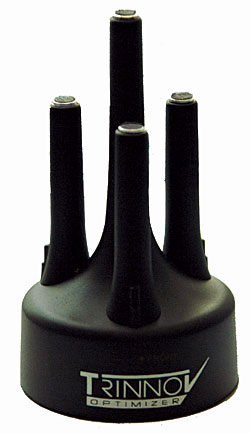Sherwood Newcastle R-972 A/V Receiver Page 2
 After you follow the setup routine described below, Trinnov lets you choose from a handful of major options. You can select these on an input-by-input basis or globally through the Quick Audio Reference Menu. Of course, you can run the system with the Trinnov Optimizer on or off. You can select microphone-setup positions 1, 2, or 3. Room EQ settings include Flat; A.Phile 1, which voices all speakers to match the front left and right; A.Phile 2, which corrects only the bass response of each channel below 300 hertz; or Natural, with a low-frequency boost below 200 Hz and a high-frequency rolloff above 9 kilohertz.
After you follow the setup routine described below, Trinnov lets you choose from a handful of major options. You can select these on an input-by-input basis or globally through the Quick Audio Reference Menu. Of course, you can run the system with the Trinnov Optimizer on or off. You can select microphone-setup positions 1, 2, or 3. Room EQ settings include Flat; A.Phile 1, which voices all speakers to match the front left and right; A.Phile 2, which corrects only the bass response of each channel below 300 hertz; or Natural, with a low-frequency boost below 200 Hz and a high-frequency rolloff above 9 kilohertz.
It also includes Spatial Mode. DLY+LVL matches distance and level for all channels. For Autoroute, I’ll quote Sherwood’s backgrounder directly: “Using the center location determined by the orientation of the microphone when the calibration is being performed, it routes each input signal to the speaker closest to the nominal channel location.” In theory, this would let you rotate the soundfield, assigning the center channel to any speaker. Then, other channel relationships would follow accordingly. The 2D Remap mode operates in the horizontal plane and can correct asymmetrical speaker placement. Finally, the 3D Remap mode compensates for speaker elevation, which should come in handy when the center speaker has to go above or below the screen.
In addition, you can set one of two remapping targets, either Cinema or Music. These are the ideal speaker placements that the Spatial modes aim to reproduce—therefore, they only operate when one of the Spatial modes is engaged. The Trinnov Optimizer also features a Cinema EQ mode that gently rolls off highs, which is a pretty common feature that THX first introduced (in slightly different form).
Setup and System
While the R-972’s setup routine took longer than usual, it didn’t challenge me more than any other auto setup routine. You can make the measurements from up to three positions, which then become user-selectable in operation. The test tones are kind of like standing under Niagara Falls—you’ll want to leave the room or plug your ears when they’re running. After that, the unit slowly computes what it’s measured. An onscreen message notes: “It may take up to 25 minutes to complete the computation procedure.” When setup is complete, you can look at the settings for each position, which include horizontal angle, vertical angle, and distance. Although I tried to exercise due care when I placed the setup microphone, the Trinnov Optimizer still chided me for misplacing the center speaker by 2 degrees. But the beauty of the system is that it’s designed to compensate for irregular speaker placements, both horizontally and vertically.

While the Optimizer is a fully formed technology, it hadn’t been fully implemented in the R-972 at press time. This required some firmware updates. Unfortunately, it wasn’t a simple matter of plugging an Ethernet cable into the back panel and hitting a few buttons on the remote. Instead, I downloaded the updates as e-mail attachments, loaded them onto a laptop, connected the laptop to the AVR with a USB-to-serial adapter cable, and executed a simple program. I loaded another update (for bass targets) from a USB stick into the front panel’s USB input. If you’d prefer a simpler life, a custom installer could handle these chores.
Associated equipment included five Paradigm Reference Studio 20 v.4 speakers running full range. Signal sources included a new addition to my system, an OPPO BDP-83SE Blu-ray player. The Special Edition moniker refers to the upgraded DACs, which I will put to good (but not public) use with my recently reinstalled Jeff Rowland two-channel gear. I’m pleased that the BDP-83SE outputs SACDs in either DSD or high-resolution PCM format. I’ll use the latter with AVRs that lack DSD decoding, including the Rotel RSX-1550 that I’ve used lately in speaker reviews. I also used a Luxman PD-289 turntable, Shure V97xE cartridge, and Bellari VP530 tubed phono preamp.
I had to make some advance decisions about the Trinnov Optimizer settings. I decided to use position-one room correction for everything and Flat room EQ for most things (except when more bass was required). It also seemed logical to use Cinema Remapping for movie demos and Music Remapping for music demos. As variables, this left the spatial Modes: DLY+LVL, Autoroute, 2D, and 3D. Including None, this added up to five options. I started with None and sub-sequently devoted the most attention to 3D.
- Log in or register to post comments






























































